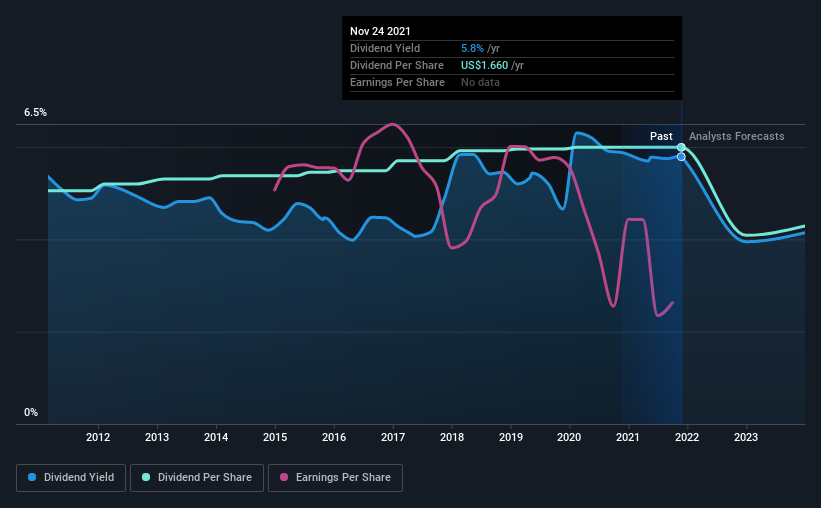PPL's (NYSE:PPL) Dividend Will Be US$0.41
The board of PPL Corporation (NYSE:PPL) has announced that it will pay a dividend on the 3rd of January, with investors receiving US$0.41 per share. This makes the dividend yield 5.8%, which will augment investor returns quite nicely.
View our latest analysis for PPL
PPL Doesn't Earn Enough To Cover Its Payments
A big dividend yield for a few years doesn't mean much if it can't be sustained. Before this announcement, PPL was paying out 147% of what it was earning, and not generating any free cash flows either. Paying out such a large dividend compared to earnings while also not generating any free cash flow would definitely be difficult to keep up.
Earnings per share is forecast to rise by 46.1% over the next year. However, if the dividend continues growing along recent trends, it could start putting pressure on the balance sheet with the payout ratio reaching 100% over the next year.
PPL Has A Solid Track Record
The company has been paying a dividend for a long time, and it has been quite stable which gives us confidence in the future dividend potential. Since 2011, the dividend has gone from US$1.40 to US$1.66. This implies that the company grew its distributions at a yearly rate of about 1.7% over that duration. Although we can't deny that the dividend has been remarkably stable in the past, the growth has been pretty muted.
Dividend Growth Potential Is Shaky
Investors could be attracted to the stock based on the quality of its payment history. Unfortunately things aren't as good as they seem. PPL's earnings per share has shrunk at 16% a year over the past five years. A sharp decline in earnings per share is not great from from a dividend perspective. Even conservative payout ratios can come under pressure if earnings fall far enough. On the bright side, earnings are predicted to gain some ground over the next year, but until this turns into a pattern we wouldn't be feeling too comfortable.
The Dividend Could Prove To Be Unreliable
In summary, while it's good to see that the dividend hasn't been cut, we are a bit cautious about PPL's payments, as there could be some issues with sustaining them into the future. Although they have been consistent in the past, we think the payments are a little high to be sustained. We would probably look elsewhere for an income investment.
Investors generally tend to favour companies with a consistent, stable dividend policy as opposed to those operating an irregular one. However, there are other things to consider for investors when analysing stock performance. Just as an example, we've come across 2 warning signs for PPL you should be aware of, and 1 of them is significant. If you are a dividend investor, you might also want to look at our curated list of high performing dividend stock.
This article by Simply Wall St is general in nature. We provide commentary based on historical data and analyst forecasts only using an unbiased methodology and our articles are not intended to be financial advice. It does not constitute a recommendation to buy or sell any stock, and does not take account of your objectives, or your financial situation. We aim to bring you long-term focused analysis driven by fundamental data. Note that our analysis may not factor in the latest price-sensitive company announcements or qualitative material. Simply Wall St has no position in any stocks mentioned.
Have feedback on this article? Concerned about the content? Get in touch with us directly. Alternatively, email editorial-team (at) simplywallst.com.

 Yahoo Finance
Yahoo Finance 
